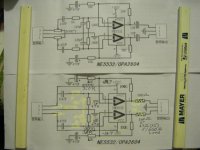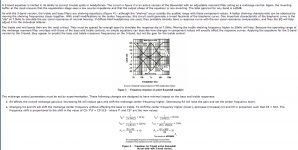Here is a 3 band equalizer that could be modified for your purpose :
HeadWize - Project: Designing A Pocket Equalizer For Headphone Listening (A HeadWize Design Series Paper)
HeadWize - Project: Designing A Pocket Equalizer For Headphone Listening (A HeadWize Design Series Paper)
Post 3152. Pin 2 is ground, Pin 1 and Pin 3 are supplied with 3kOhm current limit resistors.
Both channels go into the positive sides of the opamps. After studying this i think my circuit will work.
Flavio is recommending to supply the cartridge from batteries for safety. See my modified circuit if you want to do that. Maybe over the weekend i find the time to modify the Gilmore EQ.
Both channels go into the positive sides of the opamps. After studying this i think my circuit will work.
Flavio is recommending to supply the cartridge from batteries for safety. See my modified circuit if you want to do that. Maybe over the weekend i find the time to modify the Gilmore EQ.
Attachments
You're a MAD man.. I'll get to your Buffer ideas shortly, I have been rather busy, with updates to my speakers...
Think that yous second concept seems quite promising.. I'll run some sims on that...
Think that yous second concept seems quite promising.. I'll run some sims on that...
If i would be mad my circuits would not work. I would more call it like a flow. I work like a dog though without any apparent reason.
Thanks for simulating. Yes, your speakers need your full attention. I really admire you, that you take the trouble to design the drive units yourself.
Thanks for simulating. Yes, your speakers need your full attention. I really admire you, that you take the trouble to design the drive units yourself.
I work like a dog though without any apparent reason.
I perfectly understand you my Friend. I also do the same. It seems to bring me some peace of mind.
are you seriously venturing into tube land?
BTW some folks here are missing you at ETF.......
BTW some folks here are missing you at ETF.......
Well, Thomas Fast would like a tube output stage. I like tubes too, sure. Besides the high voltage they are easy to design with. But no, i will not devote too much time to design tube phono stages. Did you get your Starless ready and how is the mood there ? I really would love to be there but it simply did not fit into my schedule.
Joachim, with more than hundred amps built on this thread, I am asking myself. Do we get in short time a sort of TOMBOLA for DIY members, so you get rid of them ;-))
I plan to donate them to an art institute.
But good idea. I will look what circuits i can spare.
But good idea. I will look what circuits i can spare.
Joachim, we are dearly missing you at ETF!
Had the turntable shoot-out yesterday.
As always, great equipment, great people, great presentations.
Rumour has it that it will be in Germany next year.
jan didden
Had the turntable shoot-out yesterday.
As always, great equipment, great people, great presentations.
Rumour has it that it will be in Germany next year.
jan didden
Graphic EQ
Joachim,
Very interesting and useful links you gave me (us), thanks
Here is a 3 band equalizer that could be modified for your purpose :
HeadWize - Project: Designing A Pocket Equalizer For Headphone Listening (A HeadWize Design Series Paper)
Joachim,
Very interesting and useful links you gave me (us), thanks
Yes, that equalizer will work with some modifications. Just shift the midrange EQ to 3kHz,
the bass EQ a little deeper and the treble EQ up to over 10kHz. As far as i can tell you should only change the values of the caps. So in the midrange you should use 1/3rd of the value that is given for example. Just put this circuit behind my input stage. You can take even out the inverter but then you have to revers your speakers.
the bass EQ a little deeper and the treble EQ up to over 10kHz. As far as i can tell you should only change the values of the caps. So in the midrange you should use 1/3rd of the value that is given for example. Just put this circuit behind my input stage. You can take even out the inverter but then you have to revers your speakers.
So :
2 x C3 = 0.1uF
1/3 C4 = 1.66nF
1/3 C5 = 7.33nF
1/2 C6 = 2.5nF
i think the exact values are not critical.
2 x C3 = 0.1uF
1/3 C4 = 1.66nF
1/3 C5 = 7.33nF
1/2 C6 = 2.5nF
i think the exact values are not critical.
yes, it was a quasi-tangential arm and it was great! mood was great too, except my own little frustration, having fried the motor of the EMT928 i wanted to participate with in the shootout, so i arrived without it and without the starless (because i tried to fix the table), but its almost done. more later.....
I am very curious how the Starless sounds against the FPS. The circuits could not be different. Yes, Frank is the champion. He comes up with miraculous things. I am very happy that there is such life in vinyl. For tomorrow i plan a listening session with the Tanzmusik. The EQ has already proven to be a good thing. It is amazing how different records can sound when you make small changes to the frequency response. I used a Cello Palette for some time so i know what can be pushed out of unassuming recordings.
In the active 3 way Baxandall resistors R1, R2 are much too high for my taste. They add a lot of noise. I think 10k is better.
When you do not change component values of the EQ stage you can mimic RIAA by fully advancing the bass EQ and fully pushing down the treble EQ, mid EQ in middle position.
A simple linear low noise amp in front of it would give you much of what the Tanzmusik can do. The first inverter stage could be redesigned as a Phono Clone and then you are done. A variable RIAA phono stage.
When you do not change component values of the EQ stage you can mimic RIAA by fully advancing the bass EQ and fully pushing down the treble EQ, mid EQ in middle position.
A simple linear low noise amp in front of it would give you much of what the Tanzmusik can do. The first inverter stage could be redesigned as a Phono Clone and then you are done. A variable RIAA phono stage.


